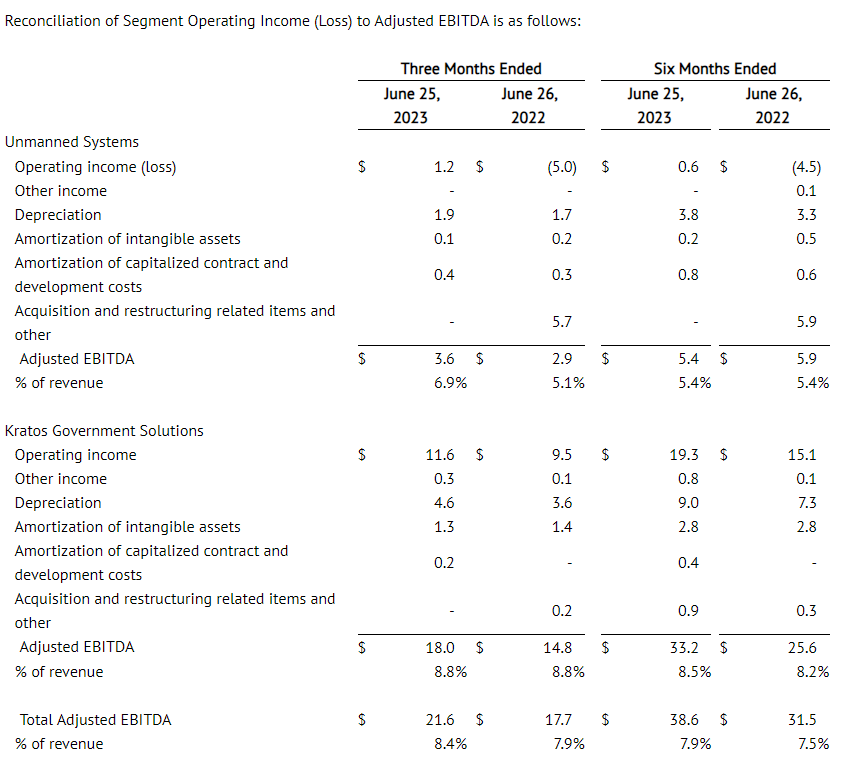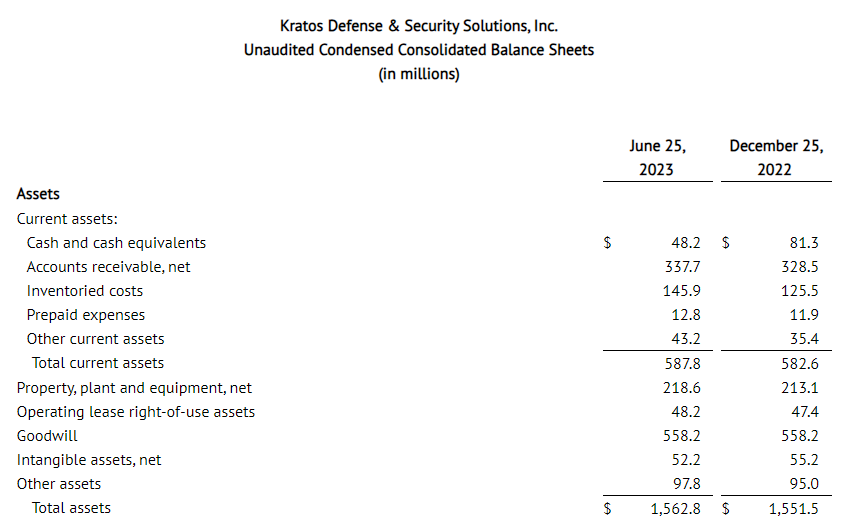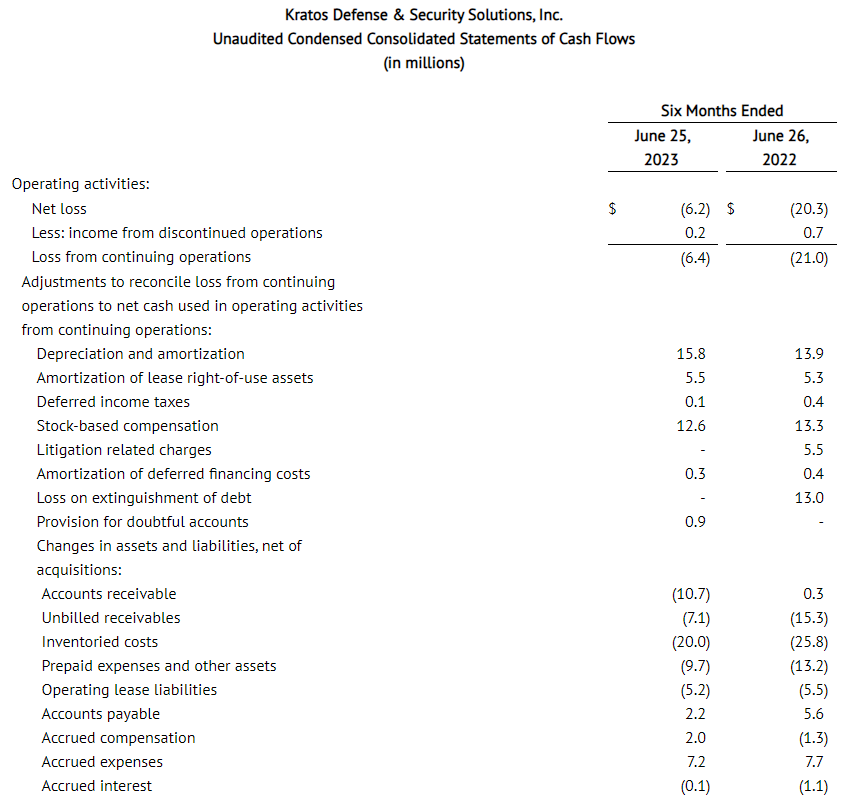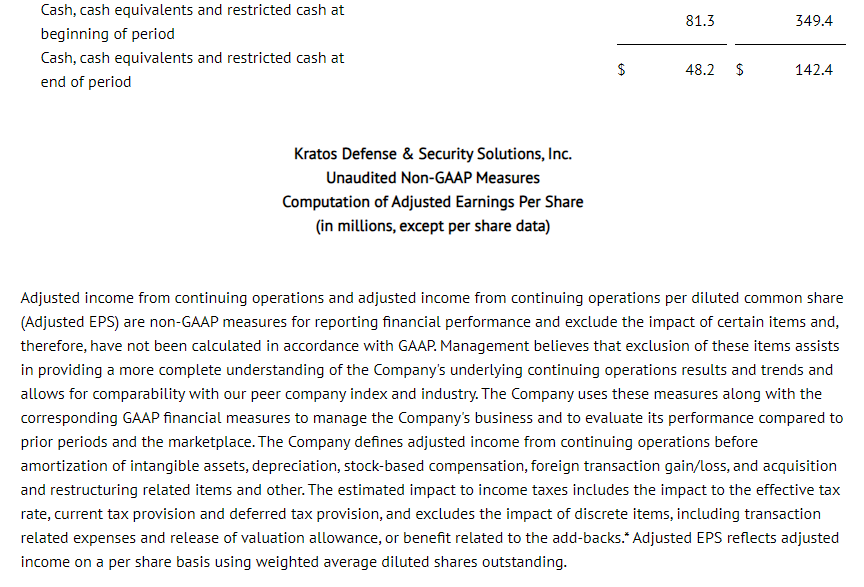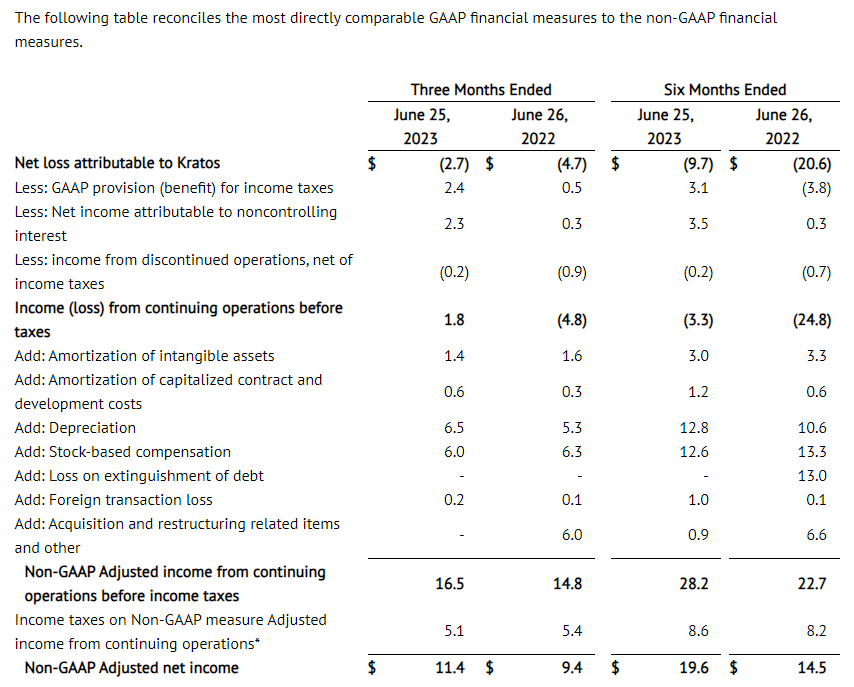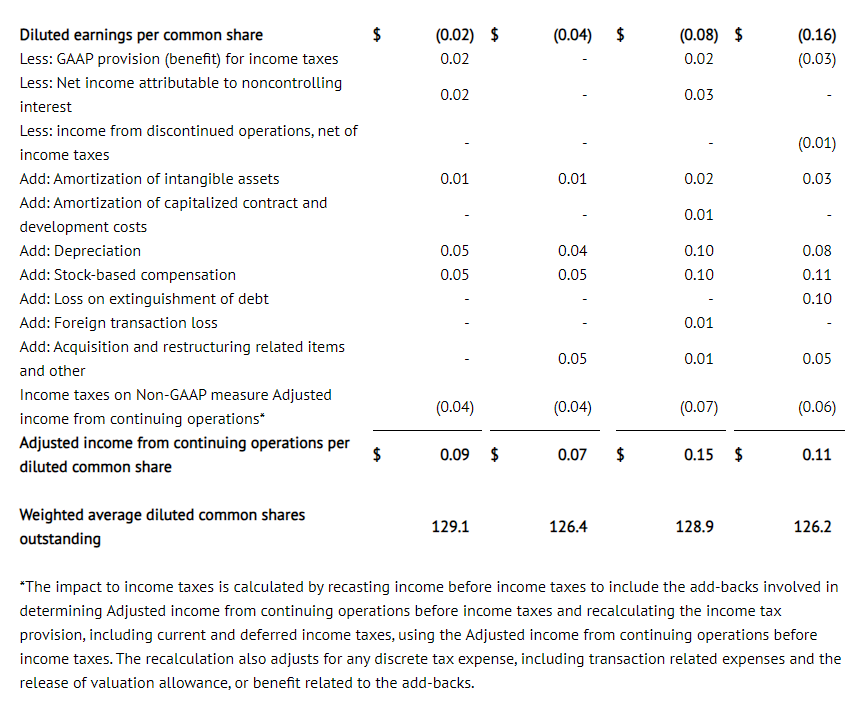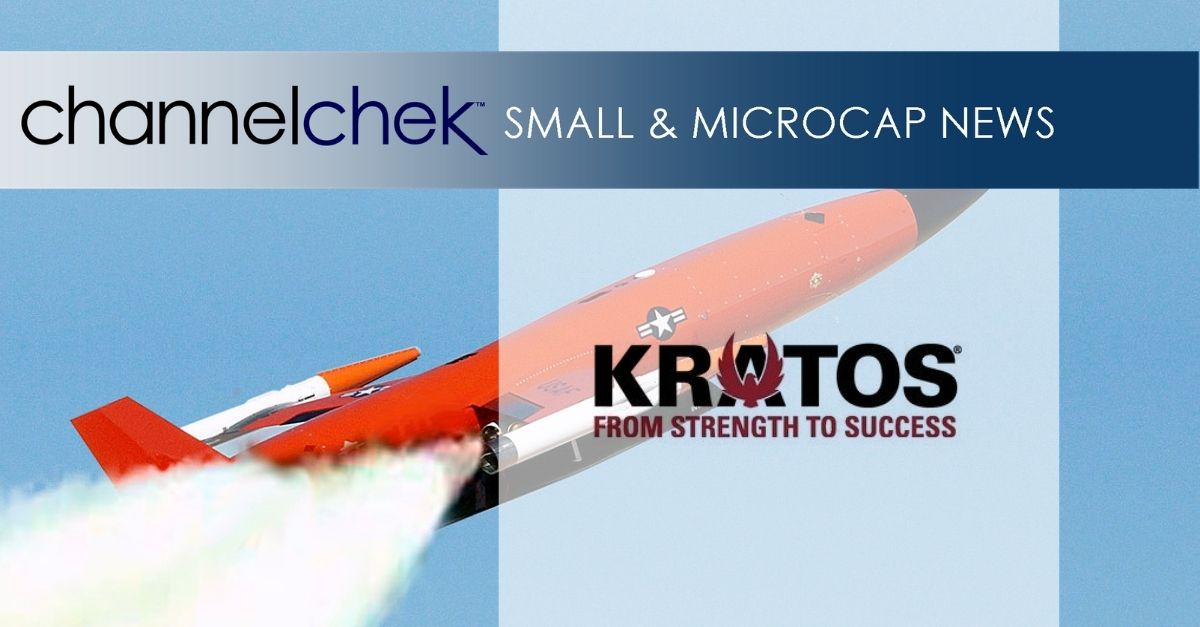
Research News and Market Data on KTOS
August 3, 2023 at 4:00 PM EDT
Second Quarter 2023 Revenues of $256.9 Million Increased 14.6 Percent Over Second Quarter 2022 Revenues of $224.2 Million, Including 17.1 Percent Organic Growth in Kratos Government Solutions Segment
Second Quarter 2023 and Last Twelve Months Ended June 25, 2023 Consolidated Book to Bill Ratio of 1.1 to 1
Affirms Full Year 2023 Financial Forecast
SAN DIEGO, Aug. 03, 2023 (GLOBE NEWSWIRE) — Kratos Defense & Security Solutions, Inc. (Nasdaq: KTOS), a Technology Company in the Defense, National Security and Global Markets, today reported its second quarter 2023 financial results. For the second quarter of 2023, Kratos reported Revenues of $256.9 million, Operating Income of $6.7 million, Net Loss of $2.7 million, Adjusted EBITDA of $21.6 million and a consolidated book to bill ratio of 1.1 to 1.0.
Included in second quarter 2023 Net Loss and Operating Income is non-cash stock compensation expense of $6.0 million and Company-funded Research and Development (R&D) expense of $9.9 million, primarily reflecting significant ongoing development efforts being made, including in our Space and Satellite business to develop our virtual, software-based OpenSpace command & control (C2), telemetry tracking & control (TT&C) and other ground system solutions. The second quarter 2023 Net Loss includes a $2.3 million loss attributable to a non-controlling interest, which includes a $2.0 million adjustment recorded to reflect the estimated increase in the value of the redeemable non-controlling interest to the estimated redemption amount by Kratos based upon current forecasted financial performance.
Kratos reported a second quarter 2023 GAAP Net Loss of $2.7 million and a GAAP Net Loss per share of $0.02, compared to a GAAP Net Loss of $4.7 million and a GAAP Net Loss per share of $0.04 for the second quarter of 2022. Adjusted earnings per share (EPS) was $0.09 for the second quarter of 2023, compared to $0.07 for the second quarter of 2022.
Second quarter 2023 Revenues of $256.9 million increased $32.7 million, or 14.6 percent, from second quarter 2022 Revenues of $224.2 million. Second quarter 2023 Revenues include contribution of $13.1 million of Revenue from the acquisition of the Engineering Division of Southern Research Institute (SRE), consolidated organic Revenue growth of 10.7 percent and organic Revenue growth of 17.1 percent in our KGS Segment, reflecting organic growth in each of the KGS businesses, with the most notable increases in our Space, Satellite and Cyber, C5ISR, and Turbine Technologies businesses.
Second quarter 2023 Cash Flow Generated from Operations was $23.6 million, reflecting the achievement of favorable billing milestones on certain contracts, offset partially by working capital requirements related to revenue growth and continued advanced inventory purchases in an effort to mitigate supply chain disruptions. Free Cash Flow Generated from Operations was $20.7 million after funding of $11.2 million of capital expenditures and receipt of $8.3 million of proceeds for sale of Valkyries that were built as Kratos capital assets.
For the second quarter of 2023, Kratos’ Unmanned Systems Segment (KUS) generated Revenues of $52.1 million, as compared to $56.4 million in the second quarter of 2022, primarily reflecting reduced tactical drone related activity as compared to 2022. KUS’s Operating Income was $1.2 million in the second quarter of 2023 compared to Operating Loss of $5.0 million in the second quarter of 2022, which included a litigation related settlement charge of $5.5 million.
KUS’s Adjusted EBITDA for the second quarter of 2023 was $3.6 million, compared to second quarter 2022 KUS Adjusted EBITDA of $2.9 million, reflecting a more favorable mix.
KUS’s book-to-bill ratio for the second quarter of 2023 was 1.2 to 1.0 and 1.3 to 1.0 for the last twelve months ended June 25, 2023, with bookings of $64.7 million for the three months ended June 25, 2023, and bookings of $266.2 million for the last twelve months ended June 25, 2023. Total backlog for KUS at the end of the second quarter of 2023 was $256.7 million compared to $244.1 million at the end of the first quarter of 2023.
For the second quarter of 2023, Kratos’ Government Solutions Segment (KGS) Revenues of $204.8 million increased 22.1 percent from Revenues of $167.8 million in the second quarter of 2022. The increased Revenues includes the contribution of approximately $13.1 million of Revenues from the SRE acquisition, and organic revenue growth in our Space, Satellite and Cyber, Turbine Technologies, C5ISR, Microwave Products and Defense Rocket Systems businesses. Excluding the SRE acquisition, KGS revenues grew organically 17.1 percent in the second quarter of 2023 as compared to the second quarter of 2022.
KGS reported operating income of $11.6 million in the second quarter of 2023 compared to $9.5 million in the second quarter of 2022, primarily reflecting the increased revenue volume. Second quarter 2023 KGS Adjusted EBITDA was $18.0 million, compared to second quarter 2022 KGS Adjusted EBITDA of $14.8 million, primarily reflecting the increased revenue volume.
Kratos’ Space, Satellite and Cyber business generated Revenues of $98.4 million in the second quarter of 2023 compared to $88.5 million in the second quarter of 2022, reflecting a 11.2 percent organic growth rate.
For the second quarter of 2023, KGS reported a book-to-bill ratio of 1.1 to 1.0, a book to bill ratio of 1.1 to 1.0 for the last twelve months ended June 25, 2023 and bookings of $217.1 million and $807.4 million for the three and last twelve months ended June 25, 2023, respectively. KGS includes Kratos’ Space, Training and Cyber business, which reported a book to bill ratio of 0.9 to 1.0 for the second quarter of 2023 and a book to bill ratio of 1.1 to 1.0 for the last twelve months ended June 25, 2023. Bookings for Kratos’ Space, Training and Cyber business for the three months and last twelve months ended June 25, 2023 were $95.6 million and $412.0 million, respectively. KGS’s total backlog at the end of the second quarter of 2023 was $900.6 million, as compared to $888.3 million at the end of the first quarter of 2023.
For the second quarter of 2023, Kratos reported consolidated bookings of $281.9 million and a book-to-bill ratio of 1.1 to 1.0, with consolidated bookings of $1.07 billion and a book-to-bill ratio of 1.1 to 1.0 for the last twelve months ended June 25, 2023. Consolidated backlog was $1.16 billion on June 25, 2023 and $1.13 billion on March 26, 2023. Kratos’ bid and proposal pipeline was $10 billion at June 25, 2023 and March 26, 2023. Backlog at June 25, 2023 was comprised of funded backlog of $863.9 million and unfunded backlog of $293.4 million.
Eric DeMarco, Kratos’ President and CEO, said, “For Q2, Kratos generated consolidated organic revenue growth of 10.7%, Adjusted EBITDA of $21.6 million, cash flow from operations of $23.6 million and free cash flow from operations of $20.7 million. Kratos’ Unmanned Systems book to bill ratio for Q2 was 1.2 to 1.0 and Kratos’ overall book to bill ratio both for the second quarter and year to date was 1.1 to 1.0. Additionally, we have a record backlog and a bid and proposal pipeline of approximately $10 billion, including hypersonic, space, propulsion system, satellite communications and drone opportunities, with several where multiple Kratos business units are collaborating in a company-wide Kratos cross-divisional pursuit.”
Mr. DeMarco continued, “Since our last quarterly report, we have successfully launched a customer’s new hypersonic system, ground tested Kratos’ new Zeus 1 solid rocket motor, including as related to Kratos’ Erinyes and Dark Fury hypersonic vehicles, received new space and satellite system program awards, including Kratos’ OpenSpace virtualized software C2 and TT&C System, reached customer agreement on a significant propulsion system program award and received a $95 million target drone system award. Kratos’ Tactical drone business also continues to progress, with multiple initiatives and customers, including bringing artificial intelligence driven combat drones to the warfighter.”
Mr. DeMarco concluded, “Kratos is a product, technology, system and software company. Kratos’ priorities include winning new program awards where Kratos offerings are disruptive differentiators, operational execution, organic growth and continued year over year increased revenue, profitability and cash flow. We will make certain, targeted investments, in areas where Kratos can be disruptive and first to market, with no significant acquisitions planned. A primary operational challenge remains obtaining and retaining qualified personnel to execute existing and expected program awards, including individuals willing and able to obtain National Security Clearances, and the significantly increased cost of these individuals, all of which every Kratos business is collaborating and working closely together to address.”
Financial Guidance
We are providing our initial 2023 third quarter financial guidance and affirming our full year 2023 guidance today, which includes our current forecasted business mix, and our assumptions, including as related to: employee sourcing, hiring and retention; manufacturing, production and supply chain disruptions; parts shortages and related continued potential significant cost and price increases, including for employees, materials and components that are impacting the industry and Kratos. The range of our expected third quarter 2023 revenues includes assumptions of forecasted execution, including the number of qualified personnel expected to be obtained and retained to successfully execute on our programs and contracts, as well as expected contract awards.
Our third quarter and full year 2023 guidance ranges are as follows:
| Current Guidance Range | ||
| $M | Q323 | FY23 |
| Revenues | $240 – $260 | $980 – $1,000 |
| R&D | $9 – $10 | $38 – $39 |
| Operating Income | $3 – $6 | $24 – $28 |
| Depreciation | $7 – $8 | $27 – $28 |
| Amortization | $2 – $3 | $8 – $10 |
| Stock Based Compensation | $6 – $7 | $24 – $26 |
| Adjusted EBITDA | $18 – $22 | $85 – $89 |
| Operating Cash Flow | $55 – $65 | |
| Capital Expenditures | $45 – $50 | |
| Free Cash Flow Generation | $10 – $20 | |
Management will discuss the Company’s financial results, on a conference call beginning at 2:00 p.m. Pacific (5:00 p.m. Eastern) today. The call will be available at www.kratosdefense.com. Participants may register for the call using this Online Form. Upon registration, all telephone participants will receive the dial-in number along with a unique PIN that can be used to access the call. For those who cannot access the live broadcast, a replay will be available on Kratos’ website.
About Kratos Defense & Security Solutions
Kratos Defense & Security Solutions, Inc. (NASDAQ: KTOS) is a Technology Company that develops and fields transformative, affordable systems, products and solutions for United States National Security, our allies and global commercial enterprises. At Kratos, Affordability is a Technology, and Kratos is changing the way breakthrough technology is rapidly brought to market – at a low cost – with actual products, systems, and technologies rather than slide decks or renderings. Through proven commercial and venture capital backed approaches, including proactive, internally funded research and streamlined development processes, Kratos is focused on being First to Market with our solutions, well in advance of competition. Kratos is the recognized Technology Disruptor in our core market areas, including Space and Satellite Communications, Cyber Security and Warfare, Unmanned Systems, Rocket and Hypersonic Systems, Next-Generation Jet Engines and Propulsion Systems, Microwave Electronics, C5ISR and Virtual and Augmented Reality Training Systems. For more information, visit www.KratosDefense.com.
Notice Regarding Forward-Looking Statements
This news release contains certain forward-looking statements that involve risks and uncertainties, including, without limitation, express or implied statements concerning the Company’s expectations regarding its future financial performance, including the Company’s expectations for its third quarter and full year 2023 revenues, R&D, operating income (loss), depreciation, amortization, stock based compensation expense, and Adjusted EBITDA, and full year 2023 operating cash flow, capital expenditures and other investments, and free cash flow, the Company’s future growth trajectory and ability to achieve improved revenue mix and profit in certain of its business segments and the expected timing of such improved revenue mix and profit, including the Company’s ability to achieve sustained year over year increasing revenues, profitability and cash flow, the Company’s expectation of ramp on projects and that investments in its business, including Company funded R&D expenses and ongoing development efforts, will result in an increase in the Company’s market share and total addressable market and position the Company for significant future organic growth, profitability, cash flow and an increase in shareholder value, the Company’s bid and proposal pipeline and backlog, including the Company’s ability to timely execute on its backlog, demand for its products and services, including the Company’s alignment with today’s National Security requirements and the positioning of its C5ISR and other businesses, ability to successfully compete and expected new customer awards, including the magnitude and timing of funding and the future opportunity associated with such awards, including in the target and tactical drone and satellite communication areas, performance of key contracts and programs, including the timing of production and demonstration related to certain of the Company’s contracts and product offerings, the impact of the Company’s restructuring efforts and cost reduction measures, including its ability to improve profitability and cash flow in certain business units as a result of these actions and to achieve financial leverage on fixed administrative costs, the ability of the Company’s advanced purchases of inventory to mitigate supply chain disruptions and the timing of converting these investments to cash through the sales process, benefits to be realized from the Company’s net operating loss carry forwards, the availability and timing of government funding for the Company’s offerings, including the strength of the future funding environment, the short-term delays that may occur as a result of Continuing Resolutions or delays in DoD budget approvals, timing of LRIP and full rate production related to the Company’s unmanned aerial target system offerings, as well as the level of recurring revenues expected to be generated by these programs once they achieve full rate production, market and industry developments, and the current estimated impact of COVID-19 and employee absenteeism, supply chain disruptions, availability of an experienced skilled workforce, inflation and increased costs, and delays in our financial projections, industry, business and operations, including projected growth. Such statements are only predictions, and the Company’s actual results may differ materially from the results expressed or implied by these statements. Investors are cautioned not to place undue reliance on any such forward-looking statements. All such forward-looking statements speak only as of the date they are made, and the Company undertakes no obligation to update or revise these statements, whether as a result of new information, future events or otherwise. Factors that may cause the Company’s results to differ include, but are not limited to: risks to our business and financial results related to the reductions and other spending constraints imposed on the U.S. Government and our other customers, including as a result of sequestration and extended continuing resolutions, the Federal budget deficit and Federal government shut-downs; risks of adverse regulatory action or litigation; risks associated with debt leverage and cost savings and cash flow improvements expected as a result of the refinancing of our Senior Notes; risks that our cost-cutting initiatives will not provide the anticipated benefits; risks that changes, cutbacks or delays in spending by the U.S. Department of Defense, or DoD, may occur, which could cause delays or cancellations of key government contracts; risks of delays to or the cancellation of our projects as a result of protest actions submitted by our competitors; risks that changes may occur in Federal government (or other applicable) procurement laws, regulations, policies and budgets; risks of the availability of government funding for the Company’s products and services due to performance, cost growth, or other factors, changes in government and customer priorities and requirements (including cost-cutting initiatives, the potential deferral of awards, terminations or reduction of expenditures to respond to the priorities of Congress and the Administration, or budgetary cuts resulting from Congressional committee recommendations or automatic sequestration under the Budget Control Act of 2011, as amended); risks that the unmanned aerial systems and unmanned ground sensor markets do not experience significant growth; risks that products we have developed or will develop will become programs of record; risks that we cannot expand our customer base or that our products do not achieve broad acceptance which could impact our ability to achieve our anticipated level of growth; risks of increases in the Federal government initiatives related to in-sourcing; risks related to security breaches, including cyber security attacks and threats or other significant disruptions of our information systems, facilities and infrastructures; risks related to our compliance with applicable contracting and procurement laws, regulations and standards; risks related to the new DoD Cybersecurity Maturity Model Certification; risks relating to the ongoing conflict in Ukraine; risks related to contract performance; risks related to failure of our products or services; risks associated with our subcontractors’ or suppliers’ failure to perform their contractual obligations, including the appearance of counterfeit or corrupt parts in our products; changes in the competitive environment (including as a result of bid protests); failure to successfully integrate acquired operations and compete in the marketplace, which could reduce revenues and profit margins; risks that potential future goodwill impairments will adversely affect our operating results; risks that anticipated tax benefits will not be realized in accordance with our expectations; risks that a change in ownership of our stock could cause further limitation to the future utilization of our net operating losses; risks that we may be required to record valuation allowances on our net operating losses which could adversely impact our profitability and financial condition; risks that the current economic environment will adversely impact our business, including with respect to our ability to recruit and retain sufficient numbers of qualified personnel to execute on our programs and contracts, as well as expected contract awards and risks related to increasing interest rates and risks related to the interest rate swap contract to hedge Term SOFR associated with the Company’s Term Loan A; currently unforeseen risks associated with COVID-19 and risks related to natural disasters or severe weather. These and other risk factors are more fully discussed in the Company’s Annual Report on Form 10-K for the period ended December 25, 2022, and in our other filings made with the Securities and Exchange Commission.
Note Regarding Use of Non-GAAP Financial Measures and Other Performance Metrics
This news release contains non-GAAP financial measures, including Adjusted EPS (computed using income from continuing operations before income taxes, excluding income (loss) from discontinued operations, excluding income (loss) attributable to non-controlling interest, excluding depreciation, amortization of intangible assets, amortization of capitalized contract and development costs, stock-based compensation expense, acquisition and restructuring related items and other, which includes, but is not limited to, legal related items, non-recoverable rates and costs, and foreign transaction gains and losses, less the estimated impact to income taxes) and Adjusted EBITDA (which includes net income (loss) attributable to noncontrolling interest and excludes, among other things, losses and gains from discontinued operations, acquisition and restructuring related items, stock compensation expense, foreign transaction gains and losses, and the associated margin rates). Additional non-GAAP financial measures include Free Cash Flow from Operations computed as Cash Flow from Operations less Capital Expenditures plus proceeds from sale of assets and Adjusted EBITDA related to our KUS and KGS businesses. Kratos believes this information is useful to investors because it provides a basis for measuring the Company’s available capital resources, the actual and forecasted operating performance of the Company’s business and the Company’s cash flow, excluding non-recurring items and non-cash items that would normally be included in the most directly comparable measures calculated and presented in accordance with GAAP. The Company’s management uses these non-GAAP financial measures, along with the most directly comparable GAAP financial measures, in evaluating the Company’s actual and forecasted operating performance, capital resources and cash flow. Non-GAAP financial measures should not be considered in isolation from, or as a substitute for, financial information presented in compliance with GAAP, and investors should carefully evaluate the Company’s financial results calculated in accordance with GAAP and reconciliations to those financial results. In addition, non-GAAP financial measures as reported by the Company may not be comparable to similarly titled amounts reported by other companies. As appropriate, the most directly comparable GAAP financial measures and information reconciling these non-GAAP financial measures to the Company’s financial results prepared in accordance with GAAP are included in this news release.
Another Performance Metric the Company believes is a key performance indicator in our industry is our Book to Bill Ratio as it provides investors with a measure of the amount of bookings or contract awards as compared to the amount of revenues that have been recorded during the period and provides an indicator of how much of the Company’s backlog is being burned or utilized in a certain period. The Book to Bill Ratio is computed as the number of bookings or contract awards in the period divided by the revenues recorded for the same period. The Company believes that the rolling or last twelve months’ Book to Bill Ratio is meaningful since the timing of quarter-to-quarter bookings can vary.
Press Contact:
Yolanda White
858-812-7302 Direct
Investor Information:
877-934-4687
investor@kratosdefense.com
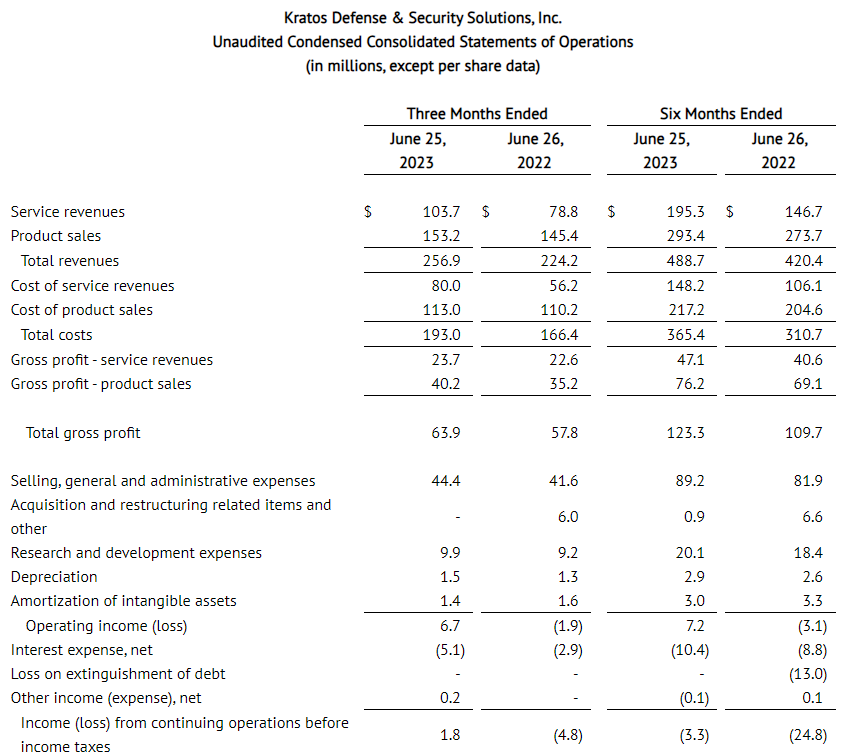
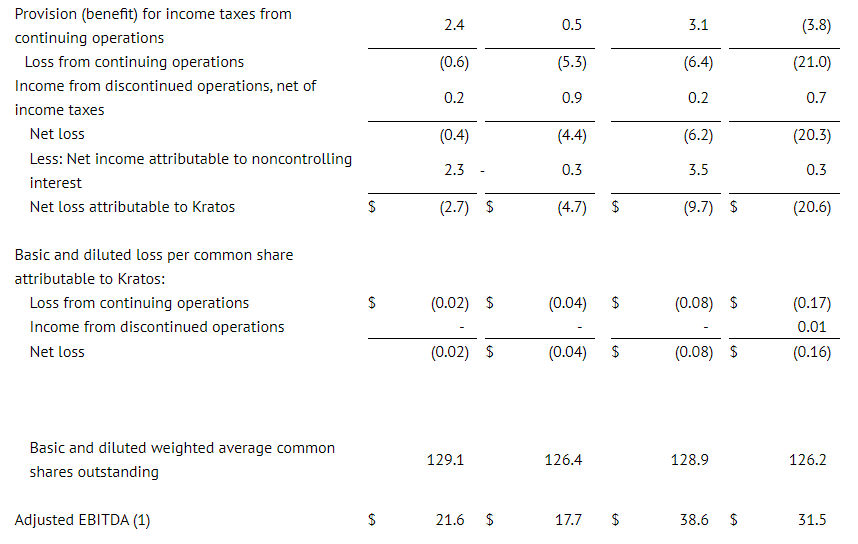
Unaudited Reconciliation of GAAP to Non-GAAP Measures
Note: (1) Adjusted EBITDA is a non-GAAP measure defined as GAAP net loss attributable to Kratos adjusted for net income attributable to noncontrolling interest, income from discontinued operations, net interest expense, provision (benefit) for income taxes, depreciation and amortization expense of intangible assets, amortization of capitalized contract and development costs, stock-based compensation, acquisition and restructuring related items and other, and foreign transaction loss.
Adjusted EBITDA as calculated by us may be calculated differently than Adjusted EBITDA for other companies. We have provided Adjusted EBITDA because we believe it is a commonly used measure of financial performance in comparable companies and is provided to help investors evaluate companies on a consistent basis, as well as to enhance understanding of our operating results. Adjusted EBITDA should not be construed as either an alternative to net income (loss) or as an indicator of our operating performance or an alternative to cash flows as a measure of liquidity. The adjustments to calculate this non-GAAP financial measure and the basis for such adjustments are outlined below. Please refer to the following table below that reconciles GAAP net loss to Adjusted EBITDA.
The adjustments to calculate this non-GAAP financial measure, and the basis for such adjustments, are outlined below:
Interest income and interest expense, net. The Company receives interest income on investments and incurs interest expense on loans, capital leases and other financing arrangements, including the amortization of issue discounts and deferred financing costs. These amounts may vary from period to period due to changes in cash and debt balances.
Income taxes. The Company’s tax expense can fluctuate materially from period to period due to tax adjustments that may not be directly related to underlying operating performance or to the current period of operations and may not necessarily reflect the impact of utilization of our NOLs.
Depreciation. The Company incurs depreciation expense (recorded in cost of revenues and in operating expenses) related to capital assets purchased, leased or constructed to support the ongoing operations of the business. The assets are recorded at cost or fair value and are depreciated over the estimated useful lives of individual assets.
Amortization of intangible assets. The Company incurs amortization of intangible expense related to acquisitions it has made. These intangible assets are valued at the time of acquisition and are amortized over the estimated useful lives.
Amortization of capitalized contract and development costs. The Company incurs amortization of previously capitalized software development and non-recurring engineering costs related to certain targets in its Unmanned Systems and ballistic missile target businesses as these units are sold.
Stock-based compensation expense. The Company incurs expense related to stock-based compensation included in its GAAP presentation of selling, general and administrative expense. Although stock-based compensation is an expense of the Company and viewed as a form of compensation, these expenses vary in amount from period to period, and are affected by market forces that are difficult to predict and are not within the control of management, such as the market price and volatility of the Company’s shares, risk-free interest rates and the expected term and forfeiture rates of the awards. Management believes that exclusion of these expenses allows comparison of operating results to those of other companies that disclose non-GAAP financial measures that exclude stock-based compensation.
Foreign transaction (gain) loss. The Company incurs transaction gains and losses related to transactions with foreign customers in currencies other than the U.S. dollar. In addition, certain intercompany transactions can give rise to realized and unrealized foreign currency gains and losses.
Acquisition and transaction related items. The Company incurs transaction related costs, such as legal and accounting fees and other expenses, related to acquisitions and divestiture activities. Management believes these items are outside the normal operations of the Company’s business and are not indicative of ongoing operating results.
Restructuring costs. The Company incurs restructuring costs for cost reduction actions which include employee termination costs, facility shut-down related costs and lease commitment costs for unused, excess or exited facilities. Management believes that these costs are not indicative of ongoing operating results as they are either non-recurring and/or not expected when full capacity and volumes are achieved.
Non-recoverable rates and costs. In fiscal 2022, the Company incurred non-recoverable rates and costs as a result of its inability to hire the required direct labor base to execute on its backlog due to a challenging environment in hiring and retaining skilled personnel. In addition, in 2022 the Company incurred non-recoverable rate growth resulting from a smaller than planned direct labor base due to delays in customer program execution and awards.
Legal related items. The Company incurs costs related to pending legal settlements and other legal related matters. Management believes these items are outside the normal operations of the Company’s business and are not indicative of ongoing operating results.
Adjusted EBITDA is a non-GAAP financial measure and should not be considered in isolation or as a substitute for financial information provided in accordance with GAAP. This non-GAAP financial measure may not be computed in the same manner as similarly titled measures used by other companies. The Company expects to continue to incur expenses similar to the Adjusted EBITDA financial adjustments described above, and investors should not infer from the Company’s presentation of this non-GAAP financial measure that these costs are unusual, infrequent, or non-recurring.

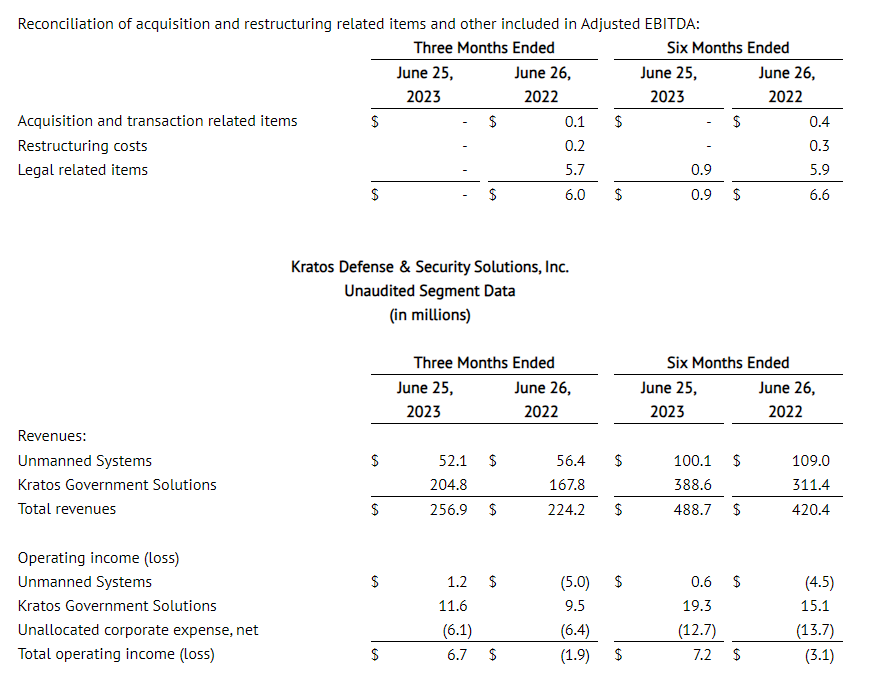
Note: Unallocated corporate expense, net includes costs for certain stock-based compensation programs (including stock-based compensation costs for stock options, employee stock purchase plan and restricted stock units), the effects of items not considered part of management’s evaluation of segment operating performance, and acquisition and restructuring related items, corporate costs not allocated to the segments, legal related items, and other miscellaneous corporate activities.
